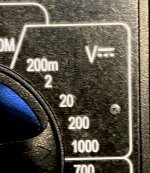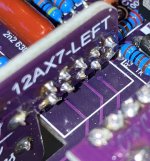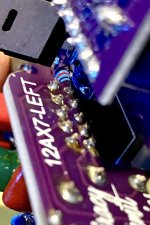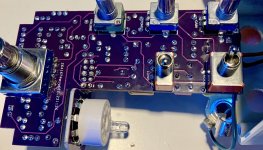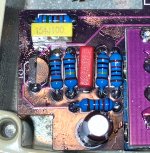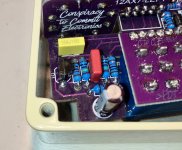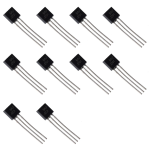joelorigo
Well-known member
Hello all, I am getting bypass signal, but nothing when activated, including no LED. I saw a previous thread with the same problem so I have already followed some of the advice there. One thing to note is that I socketed C3 & C4 to experiment later with the bass response that was discussed in an earlier thread.
First, these continuity tests are all good. (I should note that the LED comes on D&E, normal?)
3PDT switch pins:
Pedal bypassed:
Pedal bypassed:
Pin A is the input jack and F is the output jack. Pin B is the effect input.
Then, these voltage tests (using a 1.7A Godlyke Powerall 9v adaptor):
V+ pad, should be close to 9VDC (typically lower due to diode drop, but will depend on your power supply) - I get 9.17
cathode pad of D2. This is the high voltage rail, it should be 230VDC or so - I get 0, so obviously a problem there!
I am including a photo of the section of the DMM to make sure I was using the correct section.
Oh, actually the first thing I tried was a different tube.
First, these continuity tests are all good. (I should note that the LED comes on D&E, normal?)
3PDT switch pins:
Pedal bypassed:
- 1 -> 2
- 4 -> 5
- 7 -> 8
- 3 -> 2
- 6 -> 5
- 9 -> 8
Pedal bypassed:
- A -> F
- B -> C
- No continuity on other top pins
- A -> B
- C -> D
- E -> F
Pin A is the input jack and F is the output jack. Pin B is the effect input.
Then, these voltage tests (using a 1.7A Godlyke Powerall 9v adaptor):
V+ pad, should be close to 9VDC (typically lower due to diode drop, but will depend on your power supply) - I get 9.17
cathode pad of D2. This is the high voltage rail, it should be 230VDC or so - I get 0, so obviously a problem there!
I am including a photo of the section of the DMM to make sure I was using the correct section.
Oh, actually the first thing I tried was a different tube.
Attachments
Last edited:



